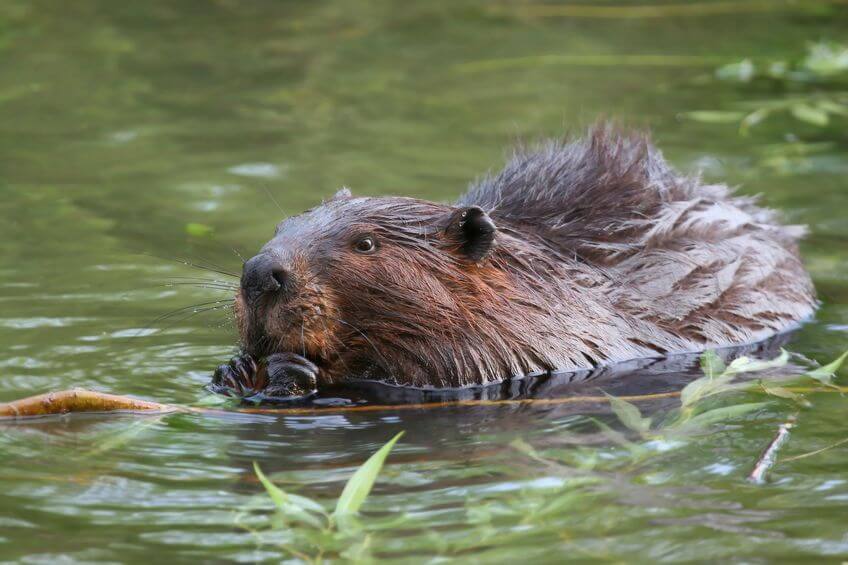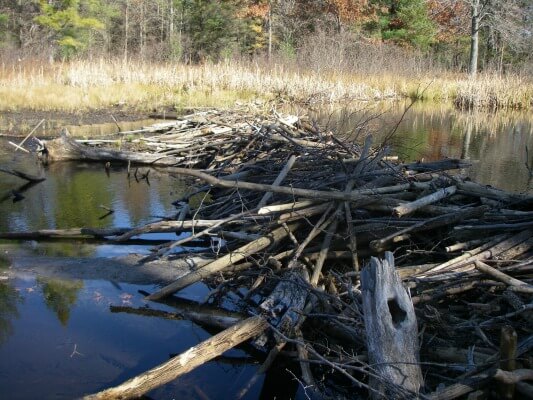- Home
- Trapping Beavers
- Facts About Beavers
Facts About Beavers
This post may contain affiliate links so I earn a commission.
There's never a shortage of fun or interesting facts about beavers.
As one of the largest rodents on earth, the beaver is truly a remarkable animal.
Although they're best known for their ability to chew through large trees and build fascinating structures, there's actually a lot of other really amazing things that many people are not aware of.
Beavers are monogamous animals who mate for life beginning in their third year.
They have anywhere from one to four kits which are born in the spring.

Living in large family groups, both parents care for the kits.
Beavers often live with their parents for 2 years until they leave to start their own family.
During this time, the yearlings (the previous years kits) can also serve as babysitters to the newly born kits.
There are two different species of beaver.
The North American beaver which is commonly called the Canada beaver, and the European beaver which is commonly called the Eurasian beaver.
While both the North American beaver and European beaver look very similar to each other and have many of the same behavioral characteristics, they are not genetically compatible.
Fun Facts About Beavers
Let's look at some fun facts about beavers that make them incredible animals both on land and under water.
1. They Can Change Their Environment
Second only to humans, beavers have the ability to change and modify their environment more than any other living creature.
Beavers build dams to alter the flow of water which not only changes the ecosystem in which they live, but it also allows them to build lodges, store food and raise a family in places that would normally be impossible without the hard work and engineering of a beaver.
2. They Have Orange Front Teeth
Beavers are large rodents that can weigh up to 40 - 60 pounds.
They have large front teeth that never stop growing.
However, instead of being white in color like ours, they are rust colored due to high amounts of iron which makes their teeth very strong.
Continually chewing on trees and bark keeps their teeth worn down and manageable, plus the orange enamel on the front of the tooth wares away at a slower rate than the white dentin on the back of the tooth.
As a result, beaver's teeth self sharpen as they chew.
3. The Largest Beaver Dam Is Visible From Space
Beavers are best known for building dams in small streams or rivers.
The dam creates a large body of water above it which is important to many different types of aquatic plants and animals.

It also creates a great place to build large hut shaped structures called beaver lodges which they use as their home.
These lodges are built from mud and sticks in open water which provides protection from predators like owls, hawks, wolves and coyotes.
The largest beaver dam in the world can be found in the Wood Buffalo National Park located in Alberta, Canada.
Stretching for 850m, the dam is visible from space!
4. They Spend Months Living Under The Ice
Beavers adapt to the cold very well and can live for months under the ice. Before the pond or lakes freeze over they create a large stash or "cache" of tree limbs near their lodge.

Aspen, cottonwood and willow are a few of their preferred tress for food.
They use this cache of limbs for their winter food supply.
How can they see what they're doing underwater?
Beavers have a set of transparent eyelids that protect their eyes while underwater......kind of like a pair of goggles!
5. Their Tails Have More Than One Purpose
They also have a broad flat tail that's used as a rudder while they're in the water or for balance while they're on land.
When threatened, they slap their tail on the surface of the water creating loud "thunk" that warns other beavers of the danger.
This splash or thunk is very distinctive and almost sounds like someone threw a large rock in the water.
6. They've Parachuted From A Plane - Facts About Beavers
To protect the local beaver population from clashing with the residents of Idaho in 1948, the Idaho Department of Fish and Game used World War 2 parachutes to drop boxes of beavers from airplanes into nearby protected areas.

The idea was devised by Elm Heter who worked for the Idaho Department of Fish and Game and it worked really well, as 75 out of 76 beavers survived the fall.
7. Their Ability To Hold Their Breath
Since they spend a majority of time underwater, it only makes sense that a beaver should be a able to hold its breath for several minutes....but what about 15?
That's right, a beaver can hold its breath and stay underwater for 15 minutes and swim up to 5 mph.
8. Beavers Hiss When They're Frightened
Aside from slapping their tails on the surface of the water when frightened, beavers also make a hissing sound.
If a beaver is hissing at you, it's best to back away and give it some space.
9. Beavers Cause Millions Of Dollars In Damage
In the United States alone, it's estimated that beavers cause $100 million of damage every year.

A majority of the loss is due to property damage caused by the beavers engineering behavior and ability to build dams which alter the flow of water.
10. They're Nocturnal - Facts About Beavers
Beavers are nocturnal meaning they're more active at night than during the daytime.
Each night a beaver will spend up to 12 hours building and maintaining their habitat.
Beavers also do not hibernate during the winter, but they will be slightly less active in the coldest months of the year.
Overall - Facts About Beavers
There are so many unique and interesting facts about beavers.
The beaver has helped shape our landscape and our history for centuries.
From their pivotal role in the fur trade industry that almost made them extinct, to their role as a keystone species creating habitat for other animals, the beaver is a remarkable animal.



